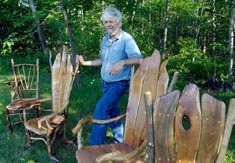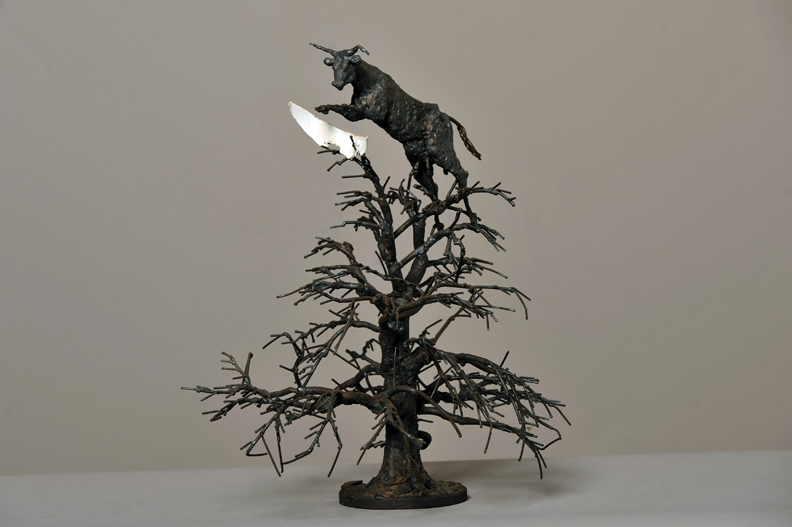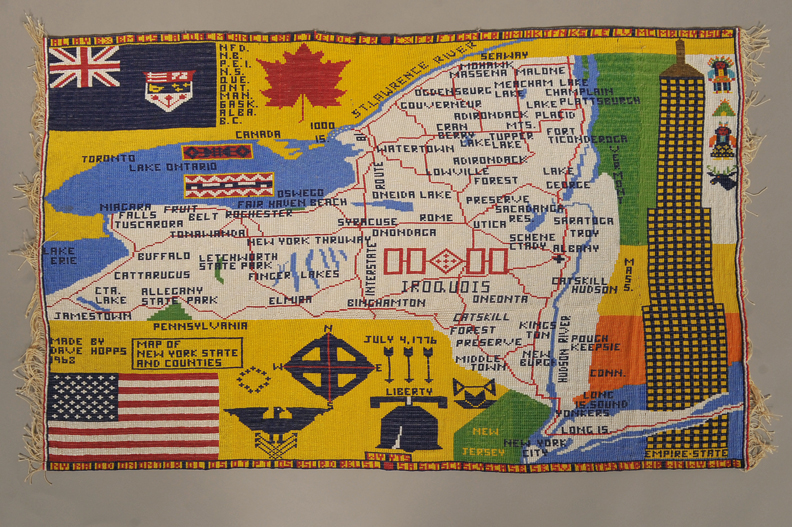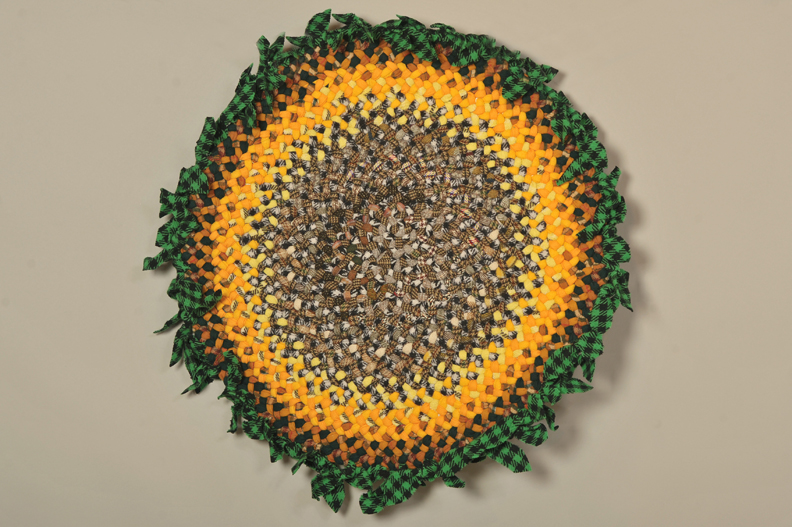Ingenuity:
Being Inventive
 The
ability to innovate within tradition is an attribute strongly admired
in some media or in the shared group expressions of some folk
communities.
The
ability to innovate within tradition is an attribute strongly admired
in some media or in the shared group expressions of some folk
communities.
An artist may experiment with forms, materials, and designs in response either to personal choices or to changing cultural influences in his or her life.
Case Study
Barry Gregson
One
of the forerunners of the current rustic movement, Barry Gregson (b. 1952) of
Schroon Lake learned wood crafts and the ways of the
woods at a young age, building lean-to’s of log and bark and later
making crude furniture while on fishing trips. He embarked on a
successful career as a stonemason, but always made rustic furniture
on the side for his own home. He started making his first
commissioned pieces in 1982 and has been
building furniture year round since then.
Each piece, from tables to free-form wall cabinets to his distinctive chairs, is an original design created from natural bends, roots, burls, and hollows from the wild. To get certain effects, Gregson uses native woods as diverse as butternut, lilac, apple, walnut, birch, and cherry. An artist-in residence at the Adirondack Museum for many years, Gregson’s work resides in the permanent collections of numerous museums and private homes and has been widely published here and abroad.
Three-Legged Rustic Chair, 2008
Courtesy of Dennis Adams
Gregson enjoys--and has become known for--the inventiveness of his Adirondack rustic pieces. While he has mastered local traditional styles such as twig mosaic and applied yellow birch bark, he also experiments with other materials and creates new forms. This piece is made with lilac roots he finds deep in the ground near the stone foundations of old homesteads. He favors lilac because of its strength and its twisted shape, "which gives it lots of character." While functional "but not very comfortable," he says "the chair is "sculptural," with legs and back of lilac and seat of several burls.
Flying Dragon, 2010
Courtesy of the artist
Rustic furniture builders like Barry Gregson scour woodlots and wildernesses for natural materials for their furniture making. They often decide what to make and how to make it based on what they find. Gregson is particularly known for creating pieces that are both functional and artistic. However, when he dug this lilac root up in one piece, he immediately spotted the form of a fiery dragon that appealed to his vivid imagination, and he created this purely decorative piece.
Merganser Ducks
William Massey, Waddington, ca. 1970
Courtesy of private collection
Bill Massey grew up on an island in the St. Lawrence River, where he hunted with his father for ducks to sell to the market. Because they used large rigs of decoys they made for themselves, Massey began to carve and paint as a child. Throughout his life, he continued to hunt over his own decoys, but took an interest in the growing popularity of decorative birds as well. A keen observer of nature, he made this pair of diving ducks that would never be put in the water.
"The Cow Jumped Over the Moon"
Richard Merchant, Cape Vincent, ca. 1970s
Courtesy of Julie Worden
This is one of dozens of whimsical, clever metal sculptures made by Richard Merchant, a dairy farmer who learned to weld in the United States Navy in World War I. He used recycled wire, tools, and other objects found around his farm to create a great variety of objects. Merchantís wry sense of humor led him to make bears and farm animals but also dragons and monsters, often in comic poses.
Beadwork Map of New York State
David Vernon Hopps, Akwesasne, 1968
Courtesy of Akwesasne Museum
Mohawk ironworker David Hopps made this stylized map of New York State entirely of glass beads, a skill he learned from traditional beadworkers. This piece includes Mohawk, Canadian, and American symbols like the maple leaf, the Liberty Bell, American and Canadian flags, and Mohawk clan motifs. He even incorporated his image of the Empire State building, the epitome of Mohawk ironworkers’ accomplishments.
Sunflower Braided Rug
Helen Condon, Parishville, 2011
Courtesy of the Artist
As a child, Helen Condon learned from her grandmother how to cut strips of used clothing and braid them into useful rugs for the family home. As an adult, she mastered the craft, creating designs of her own to sell and traveling around the Northeast to demonstrate and teach. She enjoys experimenting with fabrics and forms, like this colorful interpretation of a sunflower.
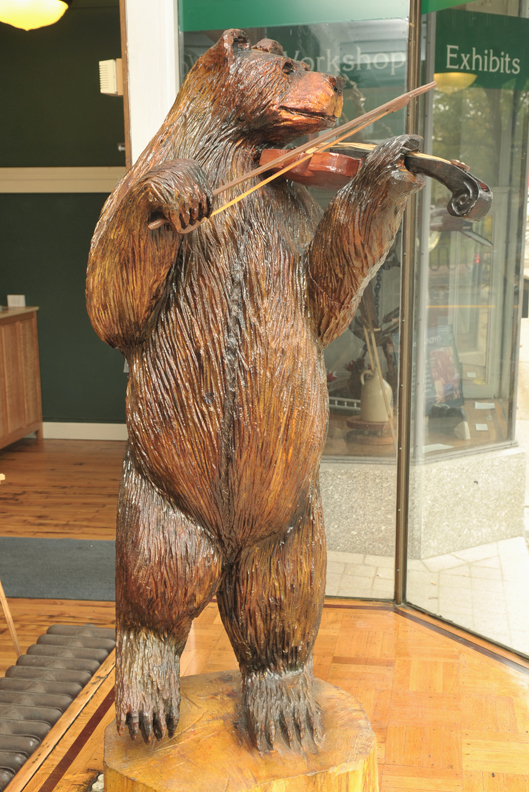 The Fiddling Bear
The Fiddling Bear
Elwood "Woody" Adams, Malone, ca. 2003
Courtesy of Ethan and Mikhail Fischer
Carving in wood with simple tools like chisels and penknives has been both an occupation and a hobby for centuries. Men at sea or in the woods passed idle time by carving useful and whimsical objects for family members and friends. Chainsaws were introduced as tools in the early 19th century, and by the 1950s a few men experimented with them to carve works of art. Woodsmen's competitions, like those still held each summer in Tupper Lake and Boonville, later began including chainsaw art contests, which has become quite sophisticated and very popular. This life-size standing bear was carved by Adams for the late attorney, Paul Fischer. Since Paul and his sons were all musical and played the fiddle, Adams gave the bear a fiddle to play and set him dancing.
Tramp Art Radio Console
Unidentified artist, Lake Luzerne
Courtesy of John & Linda Sholl
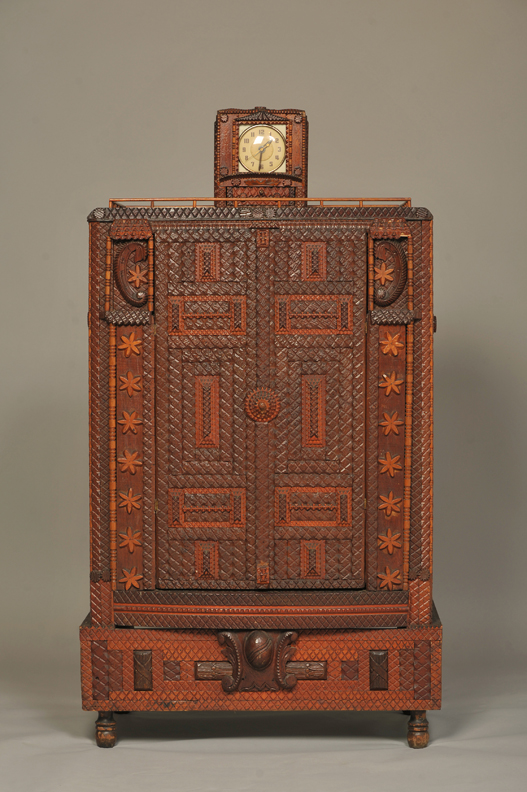
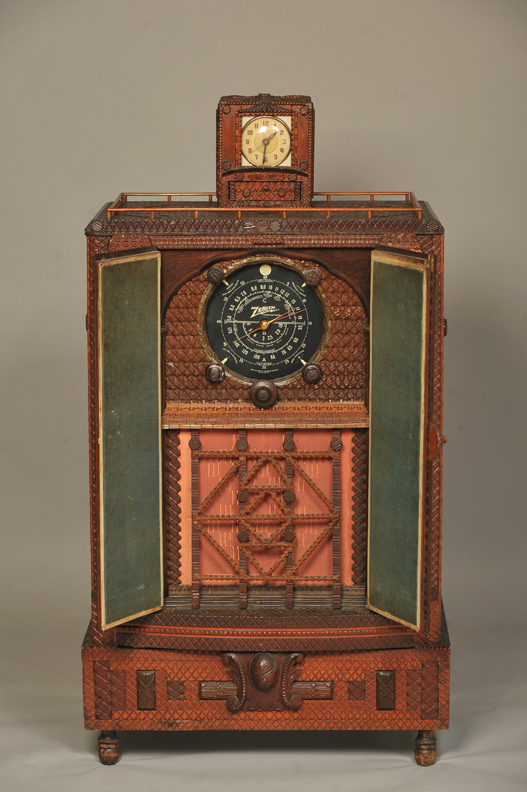 Objects carved from found and scrounged wood, particularly popular in America during the Great Depression, were sometimes called tramp art. However, there is little evidence that it was a very common art form among hobos and tramps. Commercially made radio consoles like this one by Zenith in 1937 became the centerpiece of home entertainment and were treated like good furniture. While carved pieces were often put together in layers and designs to give depth to the surface, this radio console was made a little differently. It was carved in only one layer of alternating dark and light colored wood, which was applied to all the surfaces of the original cabinet and the clock, inside and out.
Objects carved from found and scrounged wood, particularly popular in America during the Great Depression, were sometimes called tramp art. However, there is little evidence that it was a very common art form among hobos and tramps. Commercially made radio consoles like this one by Zenith in 1937 became the centerpiece of home entertainment and were treated like good furniture. While carved pieces were often put together in layers and designs to give depth to the surface, this radio console was made a little differently. It was carved in only one layer of alternating dark and light colored wood, which was applied to all the surfaces of the original cabinet and the clock, inside and out.








